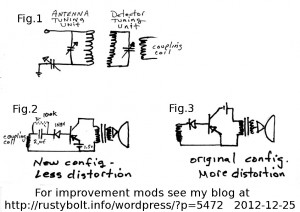 This photo was posted to the files section of the Yahoo group lost_technology. I’m including it here so others don’t have to sign up or log on to see the photo.
This photo was posted to the files section of the Yahoo group lost_technology. I’m including it here so others don’t have to sign up or log on to see the photo.
Since this was from a group for antique stuff, we will assume that this radio circuit is very old and uses Germanium transistors. The 1N34 germanium diode is very old technology and helps us date the circuit.
In fig.2 the author shows how to ‘improve’ the original circuit shown in Fig.3. In Fig.3 there was no base bias current, which in a germanium transistor isn’t so bad because they are somewhat leaky, but still this caused distortion. In Fig.2 the base bias is added by the 100k resistor.
In Fig.2, the 2 uF capacitor is much too large a value; it can be 0.1 uF or even less since it is passing RF (radio frequencies). The problem is that since the 1N34 diode is in series with the base, the RF is passing through the 1N34 and right into the transistor’s base, so the transistor is also amplifying RF. It should only be amplifying the audio frequencies for the speaker. There should be a RF bypass capacitor from the base to the emitter, about 0.01 uF or so, enough to bypass the RF and leave the audio. There should also be bypass capacitors from the collector to the emitter, and across the battery, so RF doesn’t have to go through the audio section.
But an important point that I would like to make is that in Fig.2, the 1N34 is in series with the base, so they are both detecting or rectifying the RF, so if the 1N34 was replaced with a jumper, the base would detect or rectify the RF. In other words, the 1N34 really is just duplicating what the transistor already does and really isn’t needed. And if there were bypass capacitors across the transistor, then the RF would be filtered out and only the audio would then get to the speaker.
Merry Christmas, and happy holidays.
Hello Acmefixer, Thanks for the comments on those crude schematics I posted some years ago. I will try incorporating your suggestions. I used the amp on a high performance crystal radio called the litz blitz.
I have since replaced the detector diode with a voltage multiplying version. On strong stations, the unit has the power to drive the speaker without the battery power. Albeit it rather weakly. I know we’ve conversed before. I’m the “Chemalloy battery” guy…
Regards, John
Glad to hear from you again. Thanks.